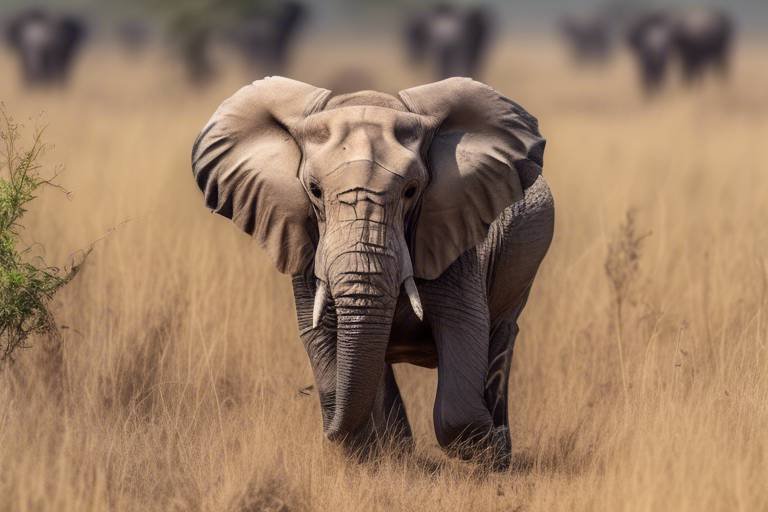Artificial Intelligence in Wildlife Conservation
In a world where our natural habitats are shrinking and endangered species are disappearing at an alarming rate, the need for innovative solutions has never been more pressing. Enter Artificial Intelligence (AI), a game-changer in the field of wildlife conservation. Imagine having the ability to track animal movements in real-time, analyze vast amounts of ecological data, and predict the behaviors of endangered species—all with the help of cutting-edge technology. AI is not just a buzzword; it's a powerful ally in our quest to protect the planet's biodiversity.
The transformative role of AI in wildlife conservation is multifaceted. From monitoring animal populations to predicting ecological changes, AI is enhancing our understanding of the natural world. It enables conservationists to gather and analyze data more efficiently, leading to informed decision-making that can save species from the brink of extinction. By leveraging AI, we can create a future where humans and wildlife coexist harmoniously.
But how exactly does AI work in this context? Think of it as a digital detective, sifting through mountains of data to uncover patterns and insights that would be nearly impossible for humans to discern alone. AI algorithms can process information from various sources—such as camera traps, acoustic sensors, and satellite imagery—to provide a comprehensive view of wildlife dynamics. This technological revolution is not just about enhancing our capabilities; it's about changing the game in conservation strategies.
In the following sections, we will delve deeper into the specific applications of AI in wildlife monitoring, data analysis, and the challenges that come with implementing these advanced technologies. We'll explore how machine learning is revolutionizing species identification, how AI-powered acoustic monitoring is giving us a voice in the wilderness, and how remote sensing is reshaping our understanding of habitats. Join us on this journey as we uncover the incredible potential of AI in wildlife conservation.
AI technologies are revolutionizing wildlife monitoring by enabling real-time tracking of animal movements, population dynamics, and habitat usage, thereby enhancing conservation efforts and data collection. Imagine being able to track the migration patterns of endangered species like the Amur leopard or the Sumatran orangutan without disturbing their natural habitat. With AI, conservationists can utilize satellite imagery and drone technology to monitor these majestic creatures from a distance, ensuring their safety while gathering crucial data.
One of the standout features of AI in wildlife monitoring is its ability to process and analyze data at a speed and scale that far exceeds human capabilities. This allows for the identification of trends and anomalies that can indicate changes in animal behavior or habitat conditions. For instance, if a particular species begins to migrate earlier than usual, AI can flag this change, prompting immediate investigation and response.
Advanced AI algorithms analyze vast datasets to identify trends, predict species behavior, and assess ecological impacts, providing valuable insights for effective conservation strategies. With the ability to crunch numbers from various data sources—such as weather patterns, human activities, and habitat conditions—AI can offer predictive modeling that helps conservationists anticipate potential threats to wildlife.
Machine learning techniques are increasingly used for species identification through image recognition, enabling faster and more accurate assessments of biodiversity in various ecosystems. Imagine a camera trap capturing thousands of images in a month. Manually identifying each species would be a Herculean task. However, with AI, these images can be processed in a fraction of the time, allowing researchers to focus on conservation efforts rather than data entry.
The integration of AI with camera traps enhances wildlife observation, automating the identification process and reducing human error while collecting vital data on species populations. This not only saves time but also ensures that the data collected is more reliable. In fact, studies have shown that AI can achieve over 90% accuracy in species identification, significantly improving the quality of data available for conservation efforts.
AI-powered acoustic monitoring systems analyze sound data to detect and identify animal calls, aiding in the study of elusive species and their habitats. This technology is particularly useful for monitoring species that are difficult to observe visually. By listening to the sounds of the forest, researchers can gather insights about animal populations and their behaviors without ever setting foot in their territory.
AI-driven remote sensing technologies facilitate habitat mapping and land-use change detection, providing critical information for habitat preservation and restoration efforts. This is essential in understanding how human activities, like deforestation and urbanization, affect wildlife habitats. With AI, conservationists can create detailed maps that highlight areas in need of protection or restoration.
Despite its potential, implementing AI in wildlife conservation faces challenges such as data quality, ethical considerations, and the need for interdisciplinary collaboration to ensure effective solutions. For instance, the accuracy of AI predictions heavily relies on the quality of the data fed into the system. Poor quality data can lead to misleading conclusions, which could ultimately harm conservation efforts.
The use of AI in conservation raises important ethical questions regarding data privacy, particularly when it involves tracking endangered species and their habitats. How do we ensure that the data collected is used responsibly and does not infringe on the rights of local communities? These questions must be addressed to ensure that AI serves as a tool for good, rather than a source of conflict.
Successful AI implementation in wildlife conservation requires collaboration among ecologists, data scientists, and policymakers to create comprehensive strategies that address both technological and ecological challenges. By bringing diverse perspectives together, we can develop solutions that are not only effective but also sustainable in the long run.
- How does AI help in wildlife conservation?
AI assists in monitoring animal populations, analyzing data, and predicting behaviors, which helps conservationists make informed decisions. - What are the ethical concerns regarding AI in conservation?
Concerns include data privacy and the potential misuse of tracking technologies. - Can AI replace human conservationists?
No, AI is a tool that enhances human efforts, but it cannot replace the critical thinking and empathy that conservationists bring.

AI Applications in Wildlife Monitoring
Artificial Intelligence (AI) is truly reshaping the landscape of wildlife monitoring, and the implications are nothing short of revolutionary. Imagine being able to track the movements of endangered species in real-time, gaining insights into their behaviors and habitats without the intrusive presence of human observers. This is not just a dream—it's becoming a reality thanks to cutting-edge AI technologies. By utilizing sophisticated algorithms and machine learning techniques, conservationists can now collect and analyze data more efficiently than ever before, leading to enhanced conservation efforts.
One of the most exciting applications of AI in wildlife monitoring is the ability to analyze vast amounts of data collected from various sources, including satellite imagery, drones, and sensor networks. These technologies allow researchers to monitor animal populations, assess habitat usage, and understand migration patterns. For instance, AI can process images captured by camera traps, identifying individual animals and tracking their movements over time. This automated identification process not only saves time but also reduces human error, allowing for more accurate population assessments.
Moreover, AI-driven systems can facilitate the use of acoustic monitoring, where sound data is analyzed to detect animal calls. This is particularly beneficial for studying elusive species that are difficult to observe directly. By employing AI algorithms, researchers can filter through thousands of hours of audio recordings to identify specific animal calls, providing insights into their behavior and habitat use.
Additionally, AI plays a crucial role in remote sensing technologies, which help in mapping habitats and detecting land-use changes. These AI systems can analyze satellite images to identify alterations in ecosystems, such as deforestation or urban expansion, which may impact wildlife. By providing critical information on habitat conditions, AI assists conservationists in making informed decisions about preservation and restoration efforts.
To put it simply, the integration of AI in wildlife monitoring is akin to having a high-tech toolbox at the disposal of conservationists. With tools like machine learning and remote sensing, they can tackle challenges that were once insurmountable. The ability to gather, process, and analyze data in real-time means that conservation strategies can be more dynamic and responsive to the needs of wildlife. As we continue to embrace these technological advancements, the future of wildlife conservation looks brighter than ever.
- How does AI improve wildlife monitoring? AI enhances wildlife monitoring by automating data collection and analysis, allowing for real-time tracking and more accurate assessments of animal populations.
- What technologies are used in AI wildlife monitoring? Technologies include camera traps, acoustic monitoring systems, drones, and satellite imagery, all of which are integrated with AI algorithms for efficient data analysis.
- Can AI help in tracking endangered species? Yes, AI plays a crucial role in tracking endangered species by enabling researchers to monitor their movements and behaviors with minimal human interference.
- What are the benefits of using AI in conservation? Benefits include improved data accuracy, time efficiency, and the ability to make data-driven decisions that enhance conservation strategies.

Data Analysis and Predictive Modeling
In the realm of wildlife conservation, are becoming indispensable tools that empower conservationists to make informed decisions. Imagine trying to solve a complex puzzle without having all the pieces; that's how challenging conservation efforts can be without proper data. Advanced AI algorithms can sift through vast amounts of data—think of it as having a supercharged detective at your disposal, ready to uncover hidden patterns and insights that would otherwise go unnoticed.
These algorithms not only analyze existing data but also predict future trends, allowing conservationists to anticipate changes in animal behavior, population dynamics, and environmental impacts. For instance, by examining historical data on animal migrations, AI can forecast where species might move in response to climate change or habitat destruction. This predictive capability is akin to having a crystal ball that helps conservationists stay one step ahead in their efforts to protect endangered species.
Moreover, the integration of machine learning techniques enhances species identification and monitoring. Imagine you're a wildlife biologist trying to catalog species in a dense forest. Traditionally, this involves extensive fieldwork and manual identification, which can be time-consuming and prone to error. With machine learning, researchers can train algorithms to recognize various species from images or sounds, speeding up the identification process significantly. This not only saves time but also increases the accuracy of biodiversity assessments, ensuring that conservation strategies are based on reliable data.
To illustrate the power of these technologies, consider the following table that highlights the key benefits of AI-driven data analysis in wildlife conservation:
| Benefit | Description |
|---|---|
| Enhanced Accuracy | AI algorithms reduce human error in species identification and data collection. |
| Real-Time Insights | Data analysis provides immediate feedback on wildlife populations and behaviors. |
| Predictive Power | Models forecast future trends, aiding in proactive conservation measures. |
| Resource Optimization | AI helps allocate resources more effectively, focusing on areas of greatest need. |
Furthermore, AI's ability to analyze ecological impacts is a game-changer. By assessing the effects of human activity on wildlife, conservationists can develop targeted strategies to mitigate negative outcomes. For example, if data shows that a particular area is experiencing a decline in a specific species due to habitat loss, conservationists can prioritize restoration efforts in that area. This data-driven approach is not just efficient; it’s essential for ensuring that conservation efforts are both impactful and sustainable.
As we continue to harness the power of AI in wildlife conservation, it’s crucial to remain mindful of the ethical implications and challenges that come with it. Questions about data privacy and the treatment of endangered species must be addressed to ensure that technology serves as a force for good in preserving our planet's biodiversity. Ultimately, the combination of data analysis and predictive modeling is revolutionizing the way we approach conservation, making it more precise, proactive, and effective in safeguarding our planet's precious wildlife.
- What is the role of AI in wildlife conservation? AI helps in monitoring wildlife, analyzing data, and predicting trends to enhance conservation efforts.
- How does predictive modeling work in conservation? It uses historical data to forecast future behaviors and trends in wildlife populations.
- What are the ethical concerns regarding AI in conservation? Issues include data privacy, the impact of tracking endangered species, and ensuring the humane treatment of wildlife.
- Can AI replace traditional conservation methods? No, AI complements traditional methods by enhancing data collection and analysis, but it cannot replace the need for human expertise.

Machine Learning in Species Identification
In the realm of wildlife conservation, machine learning has emerged as a game-changer, particularly when it comes to the identification of species. Traditional methods of species identification can be time-consuming and often rely heavily on human expertise, which can lead to inconsistencies and errors. However, with the advancement of machine learning algorithms, the process has become significantly more efficient and accurate. Imagine having a tool that can sift through thousands of images in a matter of seconds, identifying species with remarkable precision. This is the power of machine learning!
One of the most exciting applications of machine learning in species identification is through image recognition technology. By training algorithms on large datasets of labeled images, these systems can learn to recognize patterns and features that distinguish one species from another. For instance, researchers can input thousands of photographs of different birds, and the machine learning model will analyze the color patterns, shapes, and even behavioral traits to classify them accurately. This not only speeds up the identification process but also allows conservationists to monitor biodiversity more effectively.
Furthermore, the integration of machine learning with camera traps has revolutionized how we observe wildlife. These camera traps, often placed in remote areas, capture images of passing animals. With machine learning, the identification of these species can be automated. The system can process images continuously, reducing the need for human intervention and minimizing the risk of overlooking critical data. This automation is crucial, especially in regions where endangered species roam, as it ensures that every sighting is recorded and analyzed.
But wait, there's more! Machine learning isn't just about recognizing images. It also plays a vital role in analyzing the behavior of species. For example, by studying the movement patterns of certain animals through video footage, machine learning algorithms can predict their future behaviors and habitat usage. This predictive capability is invaluable for conservationists who need to implement timely interventions to protect vulnerable species.
Despite its many advantages, the use of machine learning in species identification does come with challenges. One significant hurdle is the quality of data. If the training data is biased or incomplete, the model's predictions will be unreliable. Therefore, it’s essential for researchers to curate comprehensive datasets that represent the full diversity of species in various ecosystems. Moreover, ongoing collaboration between ecologists and data scientists is crucial to refine these models and ensure they remain effective as environmental conditions change.
In summary, machine learning is not just a buzzword; it is a transformative tool that enhances our ability to identify and monitor species in the wild. By harnessing the power of technology, we can protect biodiversity more effectively and make informed decisions that benefit both wildlife and ecosystems. As we continue to explore the potential of machine learning in conservation, we can look forward to a future where the mysteries of the natural world are unveiled with unprecedented clarity.
- What is machine learning?
Machine learning is a subset of artificial intelligence that enables systems to learn from data and improve their performance over time without being explicitly programmed. - How does machine learning help in species identification?
Machine learning algorithms can analyze vast amounts of image data to recognize patterns, allowing for faster and more accurate identification of various species. - What are camera traps?
Camera traps are automated cameras that capture images or videos of wildlife in their natural habitat, often used in conservation research. - What challenges does machine learning face in conservation?
Challenges include data quality, the need for comprehensive datasets, and the requirement for interdisciplinary collaboration to refine models and ensure their effectiveness.

Camera Traps and AI Integration
Imagine wandering through a dense forest, where every rustle of leaves could be a glimpse of a rare animal. Now, what if I told you that we can capture those fleeting moments without ever disturbing the wildlife? This is where camera traps come into play, and when combined with artificial intelligence, the results are nothing short of revolutionary. Camera traps have been a game-changer in wildlife monitoring, allowing researchers to unobtrusively collect data on animal behavior, population densities, and habitat usage.
But the magic truly happens when we integrate AI into these systems. Traditional camera traps require manual checking, which can be labor-intensive and time-consuming. With AI, we can automate the process of identifying and categorizing images, drastically reducing human error and increasing efficiency. Imagine a computer program that can sift through thousands of images in mere seconds, identifying species, counting individuals, and even noting their behaviors—all without a human ever having to step into the field!
Let’s break down how this integration works. First, the camera traps are set up in strategic locations, capturing images whenever motion is detected. The data collected is then fed into an AI system that uses machine learning algorithms to analyze the images. These algorithms have been trained on vast datasets of wildlife photographs, allowing them to recognize various species with impressive accuracy. The result? A treasure trove of data that can be used to inform conservation strategies.
Here’s a quick overview of the benefits of integrating AI with camera traps:
- Efficiency: Automating image analysis saves time and resources, allowing researchers to focus on interpreting data rather than collecting it.
- Accuracy: AI reduces the chances of human error in species identification, ensuring that the data is reliable.
- Real-time Monitoring: With AI, data can be processed and analyzed in real-time, providing immediate insights into wildlife populations and movements.
However, as with any technology, there are challenges to consider. For instance, the quality of the data fed into the AI system is crucial. If the training dataset is biased or lacks diversity, the AI may struggle to accurately identify species in different environments. Additionally, the initial setup costs for integrating AI with camera traps can be significant, though the long-term benefits often outweigh these initial investments.
In conclusion, the integration of camera traps with AI technologies is transforming wildlife conservation. It not only enhances our ability to monitor and protect endangered species but also provides a deeper understanding of their behaviors and habitats. As we continue to refine these technologies, the possibilities for wildlife conservation are limitless.
- What are camera traps? Camera traps are remote cameras that automatically capture images when motion is detected, commonly used in wildlife research.
- How does AI improve the use of camera traps? AI automates the image analysis process, allowing for quicker and more accurate identification of species captured in the photos.
- What are the challenges of using AI with camera traps? Challenges include data quality, potential biases in training datasets, and the initial costs of technology integration.

Acoustic Monitoring with AI
When we think about wildlife conservation, we often picture vast landscapes and majestic animals roaming freely. However, many species are elusive and difficult to study, making traditional monitoring methods challenging. This is where AI-powered acoustic monitoring comes into play. Imagine being able to listen to the sounds of nature and decode the conversations of animals without being physically present. That's the magic of technology!
Acoustic monitoring utilizes advanced AI algorithms to analyze sound data, allowing researchers to detect and identify animal calls. This method is particularly beneficial for studying species that are hard to spot, such as nocturnal or camouflaged animals. By deploying microphones and other audio recording devices in their habitats, scientists can capture a wealth of audio data that can be processed and interpreted by AI systems.
The benefits of using AI in acoustic monitoring are numerous:
- Increased Efficiency: AI can process large volumes of audio data quickly, identifying species calls in a fraction of the time it would take a human.
- Enhanced Accuracy: With machine learning, AI systems can improve their identification capabilities over time, reducing the chances of human error.
- Real-Time Analysis: AI can provide immediate feedback on species presence, allowing for timely conservation actions.
For instance, researchers can deploy an array of microphones across a region to monitor the calls of birds, amphibians, and even mammals. The AI algorithms analyze the audio recordings, distinguishing between different species based on their unique vocalizations. This not only helps in tracking populations but also in understanding their behaviors and interactions within the ecosystem.
Moreover, the integration of acoustic monitoring with AI can also contribute to habitat assessments. By analyzing changes in vocal activity over time, conservationists can gauge the health of an ecosystem and identify potential threats, such as habitat loss or climate change impacts. This proactive approach to conservation is essential in today's rapidly changing world.
However, while the prospects of AI in acoustic monitoring are exciting, it’s crucial to acknowledge the challenges as well. The success of these technologies relies on the quality of the audio data collected and the algorithms used for analysis. Poor recording conditions or background noise can affect the accuracy of species identification. Therefore, it’s essential to ensure that the equipment is set up correctly and that the algorithms are continuously refined to adapt to varying environmental conditions.
In conclusion, represents a significant leap forward in wildlife conservation efforts. By harnessing the power of sound and advanced technology, we can gain deeper insights into the lives of animals that would otherwise remain hidden from our view. As we continue to innovate and improve these methods, the potential to protect endangered species and preserve biodiversity becomes not just a dream, but a reality.
Q1: What is acoustic monitoring?
A1: Acoustic monitoring is a method used to record and analyze sounds in a specific environment to study wildlife behavior, population dynamics, and ecosystem health.
Q2: How does AI improve acoustic monitoring?
A2: AI enhances acoustic monitoring by quickly processing large datasets, accurately identifying species calls, and providing real-time analysis, which allows for more efficient conservation efforts.
Q3: What types of species can be monitored using acoustic methods?
A3: Acoustic monitoring can be used to study various species, including birds, amphibians, and mammals, especially those that are difficult to observe directly.
Q4: Are there any challenges associated with acoustic monitoring?
A4: Yes, challenges include ensuring high-quality audio recordings, dealing with background noise, and refining AI algorithms for accurate species identification.

Remote Sensing and Habitat Mapping
Remote sensing is transforming how we understand and interact with wildlife habitats. By leveraging advanced technologies such as satellite imagery and aerial drones, conservationists can gather critical data about ecosystems from a bird’s-eye view. Imagine being able to monitor vast landscapes without ever stepping foot on them! This capability not only enhances our understanding of wildlife habitats but also supports proactive conservation efforts.
One of the most significant advantages of remote sensing is its ability to provide real-time data on land-use changes. For instance, deforestation, urbanization, and agricultural expansion can be tracked over time, allowing conservationists to respond quickly to threats. By analyzing these changes, we can identify areas at risk and prioritize them for protection. It’s like having a crystal ball that reveals the future of our natural environments!
Furthermore, remote sensing aids in habitat mapping, which is crucial for understanding the distribution of species and their ecological requirements. By creating detailed maps that illustrate different habitat types, conservationists can assess how well these areas are serving the needs of various species. This information is vital for planning conservation strategies, as it helps identify critical habitats that require immediate attention.
To illustrate the impact of remote sensing, consider the following table that highlights some key applications:
| Application | Description | Benefits |
|---|---|---|
| Satellite Imagery | Captures high-resolution images of land cover and changes over time. | Provides data for large-scale habitat assessments. |
| Aerial Drones | Utilizes drones for close-up monitoring of specific areas. | Offers detailed insights into hard-to-reach habitats. |
| GIS Technology | Integrates various data layers to analyze spatial relationships. | Enhances decision-making through visual data representation. |
However, while remote sensing offers remarkable opportunities, it also comes with its own set of challenges. Data interpretation requires expertise, and the sheer volume of information can be overwhelming. Additionally, the technology must be accessible to all stakeholders involved in conservation efforts to ensure its benefits are fully realized. This means that training and resources must be provided to local communities and conservationists alike.
In conclusion, remote sensing and habitat mapping are pivotal in the fight to conserve endangered species and their ecosystems. By harnessing the power of technology, we can gain invaluable insights into our natural world, enabling us to make informed decisions that benefit both wildlife and humanity. As we continue to innovate and improve these technologies, the potential for effective conservation strategies becomes boundless.
- What is remote sensing? Remote sensing is the acquisition of information about an object or area from a distance, typically using satellite or aerial imagery.
- How does remote sensing help in wildlife conservation? It enables conservationists to monitor habitats, assess land-use changes, and create detailed maps of ecosystems, which are essential for effective conservation strategies.
- What technologies are used in remote sensing? Technologies include satellite imagery, aerial drones, and Geographic Information Systems (GIS).
- What are the challenges of remote sensing in conservation? Challenges include the need for expertise in data interpretation, the overwhelming volume of data, and ensuring accessibility for all stakeholders.

Challenges of Implementing AI in Conservation
While the potential of artificial intelligence (AI) in wildlife conservation is vast, it is not without its challenges. One of the primary hurdles is the issue of data quality. Conservationists rely on accurate and comprehensive datasets to make informed decisions, but often, the data collected can be incomplete, biased, or outdated. This can lead to misguided strategies that may harm rather than help endangered species. For instance, if AI algorithms are trained on flawed data, they might produce inaccurate predictions about animal populations or habitat conditions, ultimately jeopardizing conservation efforts.
Another significant challenge is the ethical considerations surrounding the use of AI in conservation. The technology often involves tracking endangered species and monitoring their habitats, which raises questions about data privacy. Who owns the data collected, and how is it used? Moreover, the potential for misuse of sensitive information poses a risk that cannot be overlooked. The balance between leveraging AI for conservation and respecting the rights of wildlife and their habitats is delicate and requires careful navigation.
Furthermore, the successful implementation of AI technologies in conservation efforts demands interdisciplinary collaboration. This means that ecologists, data scientists, and policymakers must work hand-in-hand to develop comprehensive strategies that address both the technological and ecological challenges. Without this collaboration, the efforts may become disjointed, leading to inefficiencies and missed opportunities. For example, if data scientists create sophisticated AI models without ecological insight, the resulting strategies may fail to address the real-world complexities of wildlife conservation.
In addition to these challenges, the financial resources required for implementing AI solutions can be substantial. Many conservation organizations operate on tight budgets, and investing in advanced technologies might not be feasible. This financial barrier can limit access to cutting-edge tools that could otherwise enhance conservation efforts. To overcome this, it is essential for organizations to seek partnerships and funding opportunities that can help bridge the gap.
Lastly, there is the issue of public awareness and acceptance. Many people are still unfamiliar with AI and its potential benefits in conservation. To garner support, it is crucial to educate the public about how AI can help protect endangered species and preserve ecosystems. This can be achieved through community engagement, outreach programs, and transparent communication about the goals and methodologies involved in AI-driven conservation.
| Challenge | Description |
|---|---|
| Data Quality | Inaccurate or incomplete datasets can lead to misguided conservation strategies. |
| Ethical Considerations | Concerns about data privacy and the potential misuse of sensitive information. |
| Interdisciplinary Collaboration | Need for cooperation among ecologists, data scientists, and policymakers. |
| Financial Resources | High costs associated with implementing advanced AI technologies. |
| Public Awareness | Lack of understanding about AI's role in conservation among the general public. |
- What is the role of AI in wildlife conservation? AI helps in monitoring wildlife populations, analyzing data, and predicting species behavior to enhance conservation strategies.
- What are the ethical concerns regarding AI in conservation? Ethical concerns include data privacy, ownership of data, and the potential misuse of sensitive information.
- How can interdisciplinary collaboration improve AI implementation? By combining expertise from different fields, conservation strategies can be more comprehensive and effective.
- What financial challenges do conservation organizations face with AI? Many organizations operate on limited budgets, making it difficult to invest in advanced technologies.
- How can public awareness be raised about AI in conservation? Through community engagement, outreach programs, and transparent communication about AI's benefits in wildlife protection.

Data Privacy and Ethical Concerns
As we leap into the exciting world of artificial intelligence (AI) in wildlife conservation, we must pause and reflect on the ethical implications that accompany this technological revolution. While AI offers incredible tools for monitoring endangered species and preserving ecosystems, it also raises significant questions about data privacy and ethical responsibility. Imagine a world where every movement of a rare animal is tracked in real-time. Sounds impressive, right? But what happens to the data collected? Who has access to it, and how is it used?
One of the primary concerns revolves around the tracking of endangered species. When we deploy AI systems to monitor these animals, we often collect sensitive information about their habitats and behaviors. This data can be invaluable for conservation efforts, but it also poses risks. For instance, if this information falls into the wrong hands, it could lead to poaching or habitat destruction. The question then arises: how do we balance the need for data collection with the imperative to protect these vulnerable species?
Furthermore, the use of AI in wildlife conservation often involves collecting data from various sources, including camera traps and acoustic monitoring systems. Each of these sources generates a wealth of information that, while beneficial for conservation, can compromise the privacy of both the animals and the surrounding ecosystems. It’s essential to establish clear guidelines on how this data is collected, stored, and shared. Without proper regulations, we risk crossing ethical boundaries that could harm the very species we aim to protect.
To navigate these complex waters, conservationists and technologists must work together to create a framework that prioritizes ethical considerations. This framework should include:
- Data Minimization: Collect only the data that is necessary for conservation efforts.
- Transparency: Clearly communicate how data will be used and who will have access to it.
- Consent: Seek permission from relevant stakeholders, including local communities, before deploying monitoring technologies.
In addition to these considerations, there’s a pressing need for ongoing dialogue about the implications of AI in wildlife conservation. Engaging with local communities and stakeholders can provide valuable insights and foster trust, ensuring that conservation efforts are both effective and ethical. After all, the ultimate goal is to protect our planet's biodiversity while respecting the rights and concerns of those who inhabit it.
In conclusion, while the integration of AI in wildlife conservation presents groundbreaking opportunities, we must tread carefully. By addressing data privacy and ethical concerns head-on, we can harness the power of technology to protect endangered species without compromising their safety or privacy. It’s a delicate balance, but one that is crucial for the future of our planet’s wildlife.
- What are the main ethical concerns regarding AI in wildlife conservation? The primary concerns include data privacy, potential misuse of information, and the need for transparency in data collection.
- How can we ensure the ethical use of AI in wildlife conservation? Establishing clear guidelines, engaging with local communities, and prioritizing data minimization can help ensure ethical practices.
- Is AI technology safe for monitoring endangered species? While AI technology can enhance monitoring efforts, it must be implemented responsibly to protect the species being monitored.

Interdisciplinary Collaboration for Success
When it comes to the successful implementation of artificial intelligence (AI) in wildlife conservation, interdisciplinary collaboration is not just a luxury; it's a necessity. Imagine a puzzle where each piece represents a different field of expertise—ecologists, data scientists, technologists, and policymakers all need to come together to form a complete picture. Without this collaboration, we risk missing crucial insights that could help protect endangered species and preserve our ecosystems.
For instance, ecologists possess in-depth knowledge about animal behaviors and habitat requirements, while data scientists bring expertise in analyzing complex datasets. When these two groups join forces, they can develop AI models that are not only technically sound but also ecologically relevant. This synergy allows for the creation of conservation strategies that are informed by real-world ecological data, leading to more effective outcomes.
Moreover, the integration of policy-making is vital. Policymakers must understand the technological advancements in AI to craft regulations that support conservation efforts while also addressing ethical concerns, such as data privacy. For example, when tracking endangered species, it's critical to ensure that the data collected does not infringe on their natural behaviors or habitats. This is where the collaboration between technologists and policymakers becomes crucial, as they can work together to establish guidelines that protect both wildlife and the integrity of the data collected.
To illustrate the importance of this interdisciplinary approach, consider the following table that outlines the roles of different stakeholders in AI-driven wildlife conservation:
| Stakeholder | Role in Conservation |
|---|---|
| Ecologists | Provide insights into species behavior and habitat needs. |
| Data Scientists | Analyze data to identify trends and develop predictive models. |
| Technologists | Develop AI tools and technologies for wildlife monitoring. |
| Policymakers | Create regulations that guide ethical AI use in conservation. |
In addition to these roles, it's essential to foster an environment where continuous learning and adaptation are encouraged. The field of AI is always evolving, and so are the challenges faced in wildlife conservation. Regular workshops, seminars, and collaborative projects can help stakeholders stay updated on the latest technologies and methodologies. By sharing knowledge and resources, we can create a robust framework that enhances the effectiveness of AI in conservation.
In conclusion, the path to successful AI implementation in wildlife conservation is paved with collaboration. By breaking down silos and encouraging interdisciplinary partnerships, we can harness the power of AI to make a significant impact in protecting our planet's most vulnerable species. After all, when it comes to conservation, we're all in this together!
- What is the role of AI in wildlife conservation? AI helps in monitoring wildlife, analyzing data, and predicting behaviors, which enhances conservation strategies.
- Why is interdisciplinary collaboration important? It brings together diverse expertise, leading to more effective and informed conservation efforts.
- What are the ethical concerns associated with AI in conservation? Issues include data privacy and the impact of tracking technologies on wildlife behavior.
- How can stakeholders work together effectively? Through regular communication, shared projects, and workshops to foster understanding and collaboration.
Frequently Asked Questions
- What role does AI play in wildlife conservation?
AI plays a transformative role in wildlife conservation by enabling real-time monitoring of animal movements, population dynamics, and habitat usage. It enhances data collection, allowing conservationists to make informed decisions to protect endangered species and preserve ecosystems.
- How does AI improve wildlife monitoring?
AI improves wildlife monitoring through technologies like camera traps and acoustic monitoring systems. These tools automate species identification and analyze sound data, respectively, thus providing vital information about animal populations and their behaviors without the need for constant human observation.
- Can AI help in species identification?
Absolutely! Machine learning algorithms are increasingly used for species identification via image recognition. This technology enables faster and more accurate assessments of biodiversity, helping researchers to quickly identify and catalog various species in different ecosystems.
- What are the challenges of implementing AI in conservation?
Implementing AI in conservation comes with challenges such as data quality issues, ethical concerns regarding data privacy, and the necessity for interdisciplinary collaboration. These hurdles must be addressed to ensure that AI solutions are effective and responsible in protecting wildlife.
- How does AI address ethical concerns in wildlife conservation?
AI addresses ethical concerns by promoting transparency and responsible data use. It is crucial to establish guidelines for tracking endangered species and their habitats, ensuring that the data collected respects privacy and supports conservation efforts without causing harm.
- What is the importance of interdisciplinary collaboration in AI conservation efforts?
Interdisciplinary collaboration is vital because successful AI implementation requires expertise from ecologists, data scientists, and policymakers. By working together, these professionals can develop comprehensive strategies that tackle both technological and ecological challenges effectively.



















